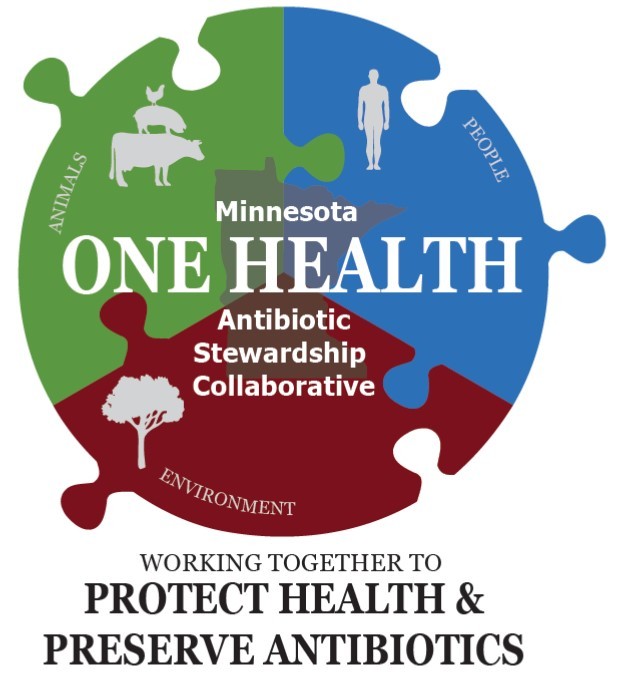Minnesota Department of Health MN Antibiotic Stewardship Collaborative Update Bulletin
Minnesota Department of Health sent this bulletin at 09/23/2016 02:09 PM CDT
Stewardship quiz? You betcha! (scroll down for answer)
In 2014, 718 incident cases of Clostridium difficile (“C. diff”) infection were reported in Minnesota’s 5 sentinel counties (183 cases per 100,000 population). What percent of these infections were “community-associated”, or occurring outside of a health care setting?
a. 5%
b. 25%
c. 55%
d. 70%
Update from Your Minnesota Stewardship Collaborative
Encourage your health care facility leadership to commit to stewardship!
Pass on the Call to Action from the Collaborative Healthcare-Associated Infection Network (CHAIN)
In response to the national changes around antibiotic stewardship and Minnesota’s One Health Stewardship Collaborative, CHAIN has issued a Call to Action to all Minnesota hospitals. Read more
Stay tuned for meeting announcements, including:
- One Health Coalition full workgroup meeting (November or December 2016)
- Human Health Care Antibiotic Stewardship Conference (Winter 2017)
News to Note
For the first time in U.S., gonorrhea infections found with both decreased susceptibility to ceftriaxone and very high-level resistance to azithromycin . Read more
- Isolates collected from 7 persons in Honolulu in April and May of 2016 showed much higher levels of azithromycin resistance than typically seen in the U.S., and 5 isolates had reduced ceftriaxone susceptibility
- Ceftriaxone and azithromycin are the two drugs that make up the dual regimen that is the last available effective gonorrhea treatment option
Importance of a One Health approach highlighted at United Nations General Assembly High-level Meeting on Antimicrobial Resistance. Read more
- “We…recognize that the overarching principle for addressing antimicrobial resistance is the promotion and protection of human health within the framework of a One Health approach, emphasize that this requires coherent, comprehensive and integrated multisectoral action, as human, animal, and environmental health are interconnected…” (excerpted from the political declaration)
- Read the entire political declaration here
Third Public Meeting of Presidential Advisory Council on Combating Antibiotic Resistant Bacteria (PACCARB) was held on September 19, 2016. Read more
FDA Seeks Public Input on Next Steps to Help Ensure Judicious Use of Antimicrobials in Animal Agriculture. Read more
- Some FDA-approved antimicrobials used in animal feed and water have therapeutic indications but no defined duration of use
- FDA has published a notice requesting information from the public on how to establish target durations of use for products affected by the recent Guidance for Industry #213, which limits medically important antimicrobials to therapeutic-only use
- FDA seeks information on the diseases requiring these drugs for therapeutic purposes, risk period(s) for developing these diseases, more-targeted therapeutic or management measures that might help avoid or decrease need for these drugs, and strategies for updating the affected labels
In France, new insights into epidemiology of colistin resistance among carbapenem-resistant Enterobacteriaceae (CRE). Read more
- A high percentage of carbapenemase-producing Klebsiella (6%; 35/561) and Enterobacter (7.7%; 7/91) isolates were also resistant to colistin, but no plasmid-encoded mcr-1 gene resistance was detected
- Understanding the mechanism of colistin resistance and the capacity for plasmid-mediated spread has implications for wider detection and control of multi-drug resistance
Carbapenemase NDM-1 identified in 27 Vibrio fluvialis isolates from patients with diarrhea in Kolkata, India. Read more
- Although the NDM-1 gene has been associated with many members of the Enterobacteriaceae family of bacteria, there are few reports of the resistance gene associated with enteric bacteria
- These findings raise concerns about the potential for plasmid-mediated resistance spread among enteric bacteria
Food and Agriculture Organization (FAO) releases “The FAO Action Plan on Antimicrobial Resistance, 2016–2020” to help countries develop strategies to impact resistance in food and agriculture sectors. Read more
September is Sepsis Awareness Month. Read more
Upcoming Events
Collaborative Healthcare-Associated Infection Network (CHAIN) Fall Conference
- September 28, 2016 in Brooklyn Center, MN
- Learn more
National Institute for Animal Agriculture 2016 Antibiotics Symposium
- November 1-3, 2016 in Herndon, VA
- Learn more
ComplianceIQ Webinar on Veterinary Pharmacy Laws and Regulations
- October 28, 2016
- Learn more
One Health Day
- November 3, 2016
- Learn more
Get Smart About Antibiotics Week
- November 14–20, 2016
- Learn more
Quiz Answer!
Correct Answer: c. 55%
In 2014, 718 incident cases of Clostridium difficile infection were reported to MDH from five sentinel counties (183 per 100,000 population). Fifty-five percent of these cases were classified as community-associated and 45% as health care facility-associated. Of the patients with community-associated C. difficile infection, 58% were prescribed antibiotics in the 12 weeks prior to stool specimen collection, compared to >80% of those health care-associated infection. Upon interview, patients with community-associated infection were prescribed antibiotics for treatment of ear, sinus, or upper respiratory infections, skin infections, dental procedures, and urinary tract infections.
Because antibiotic use can affect normal bacterial populations in the gut, poor prescribing practices contribute to unnecessary patient risk for C. difficile infection. CDC indicates that 30-50% of antibiotics prescribed in hospitals and outpatient settings are unnecessary or incorrect. However, prudent use of antibiotics will not eliminate the threat of C. difficile infection in or outside of health care settings. A comprehensive approach, including hand hygiene and good infection prevention practices, is necessary.
C. difficile is an important cause of infectious disease death in the United States. C. difficile was estimated by CDC to cause almost half a million infections in the United States in 2011. Approximately 83,000 of the patients who developed C. difficile experienced at least one recurrence and 29,000 died within 30 days of the initial diagnosis.
Learn more about C. difficile in Minnesota
Handy Links
Minnesota One Health Collaborative
CIDRAP: Antimicrobial Stewardship
USDA: Antimicrobial Resistance
Having trouble viewing this email? View it as a Web page.

